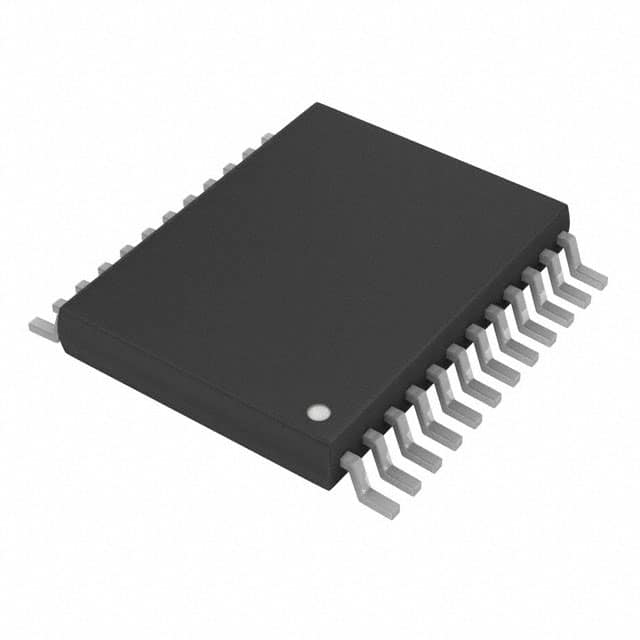Viz Specifikace pro podrobnosti o produktu.

PCF8575CDGVR
Product Overview
- Category: Integrated Circuit (IC)
- Use: I/O Expander
- Characteristics: High-speed, 16-bit remote I/O expander for I2C-bus applications
- Package: TSSOP-24
- Essence: PCF8575CDGVR is a versatile I/O expander IC designed for expanding the number of input/output pins in microcontroller-based systems.
- Packaging/Quantity: Available in tape and reel packaging with 2500 units per reel.
Specifications
- Supply Voltage Range: 2.3V to 5.5V
- I/O Voltage Range: 0V to VDD
- I2C-bus Interface: Compatible with I2C-bus Fast-mode and Standard-mode
- Maximum Frequency: 400 kHz
- Number of I/O Pins: 16
- Interrupt Output: Active LOW open-drain interrupt output
- Operating Temperature Range: -40°C to +85°C
Detailed Pin Configuration
The PCF8575CDGVR has a total of 24 pins arranged as follows:
- SDA: Serial Data Input/Output pin for I2C communication.
- SCL: Serial Clock Input pin for I2C communication.
- A0-A2: Address Select pins for device addressing.
- INT: Interrupt Output pin. 5-20. P0-P7: General Purpose I/O pins. 21-24. GND: Ground pins.
- VDD: Supply Voltage pin.
Functional Features
- Bidirectional I/O Expansion: The PCF8575CDGVR provides 16 additional I/O pins that can be configured as either inputs or outputs.
- I2C-bus Interface: It supports the I2C-bus protocol, allowing easy integration with microcontrollers and other devices.
- Interrupt Output: The INT pin can be used to generate an interrupt signal to the microcontroller when a change in input status is detected.
- Low Power Consumption: The IC operates at low power, making it suitable for battery-powered applications.
Advantages and Disadvantages
Advantages: - Easy Integration: Compatible with standard I2C-bus interface, simplifying system design. - Versatility: Can be used in various applications requiring additional I/O pins. - Low Power Consumption: Ideal for energy-efficient designs.
Disadvantages: - Limited I/O Pins: Only provides 16 additional I/O pins, which may not be sufficient for certain complex systems. - I2C-bus Dependency: Relies on the I2C-bus protocol for communication, which may introduce additional complexity.
Working Principles
The PCF8575CDGVR works by communicating with a microcontroller or other devices through the I2C-bus interface. It acts as an I/O expander, allowing the microcontroller to control and monitor multiple input/output signals using only a few pins. The device's address can be configured using the A0-A2 pins, enabling the use of multiple PCF8575CDGVR ICs in the same system.
Detailed Application Field Plans
The PCF8575CDGVR finds applications in various fields, including:
- Industrial Automation: Used for expanding the number of I/O pins in industrial control systems.
- Home Automation: Enables the control of multiple devices and sensors in smart home applications.
- Automotive Electronics: Provides additional I/O capabilities for automotive control units.
- Internet of Things (IoT): Facilitates the connection of multiple sensors and actuators in IoT devices.
- Robotics: Used to expand the I/O capabilities of robotic systems.
Detailed and Complete Alternative Models
- MCP23017: Similar I/O expander IC with 16 I/O pins and I2C-bus interface.
- MAX7313: I/O expander IC with 16 I/O pins, SPI interface, and interrupt capabilities.
- PCA9555: 16-bit I/O expander IC with I2C-bus interface and interrupt output.
These alternative models offer similar functionality to the PCF8575CDGVR and can be considered as alternatives based on specific requirements.
Word count: 446 words
Seznam 10 běžných otázek a odpovědí souvisejících s aplikací PCF8575CDGVR v technických řešeních
Sure! Here are 10 common questions and answers related to the application of PCF8575CDGVR:
Question: What is PCF8575CDGVR?
- Answer: PCF8575CDGVR is an I/O expander IC (integrated circuit) manufactured by Texas Instruments. It provides additional input/output pins for microcontrollers or other digital devices.Question: How many I/O pins does PCF8575CDGVR have?
- Answer: PCF8575CDGVR has a total of 16 I/O pins, which can be configured as either inputs or outputs.Question: What is the voltage range supported by PCF8575CDGVR?
- Answer: PCF8575CDGVR supports a voltage range of 2.3V to 5.5V, making it compatible with a wide range of microcontrollers and digital devices.Question: Can PCF8575CDGVR handle both analog and digital signals?
- Answer: No, PCF8575CDGVR is designed to handle only digital signals. It cannot process analog signals directly.Question: How can PCF8575CDGVR be controlled by a microcontroller?
- Answer: PCF8575CDGVR uses the I2C (Inter-Integrated Circuit) protocol for communication with a microcontroller. The microcontroller sends commands and data to control the I/O pins of PCF8575CDGVR.Question: What is the maximum current that can be sourced/sunk by each I/O pin of PCF8575CDGVR?
- Answer: Each I/O pin of PCF8575CDGVR can source/sink up to 25mA of current.Question: Can PCF8575CDGVR be used to drive high-power devices directly?
- Answer: No, PCF8575CDGVR is not designed to drive high-power devices directly. It is recommended to use external drivers or relays for such applications.Question: Can multiple PCF8575CDGVR ICs be connected together?
- Answer: Yes, multiple PCF8575CDGVR ICs can be connected together on the same I2C bus, allowing for expansion of I/O pins beyond 16.Question: Is PCF8575CDGVR suitable for battery-powered applications?
- Answer: Yes, PCF8575CDGVR has a low power consumption and can be used in battery-powered applications where power efficiency is important.Question: Are there any application examples for PCF8575CDGVR?
- Answer: Yes, PCF8575CDGVR can be used in various applications such as keypad interfacing, LED matrix control, digital sensors interfacing, and general-purpose I/O expansion.
Please note that these answers are general and may vary depending on specific implementation details and requirements.

